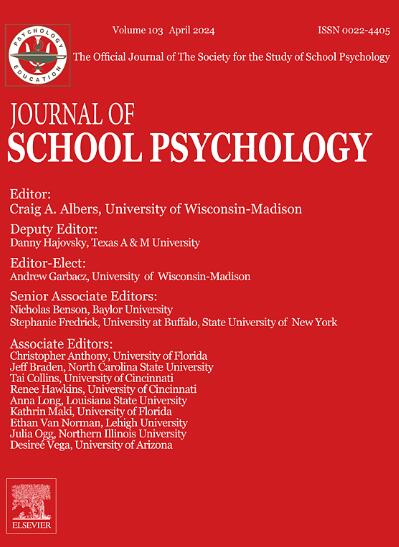Happy together: Multilevel associations between adolescents' and teachers' school-specific subjective wellbeing
IF 4.1
1区 心理学
Q1 PSYCHOLOGY, SOCIAL
引用次数: 0
Abstract
International literature indicates that adolescents' subjective well-being (SWB) is associated with their academic and social-emotional development. Teachers are a central source of social influence on adolescents' school-specific SWB. However, little is known about the multilevel associations between adolescents' and their teachers' school-specific SWB, especially in collectivist cultures. This international collaborative study examined the multilevel associations between adolescents' and their teachers' school-specific SWB. Using a stratified random sample from a public secondary school in China (nstudent = 1181, nteacher = 44), we surveyed teachers' and their students' school-specific SWB and general SWB (i.e., satisfaction with life and general self-efficacy). Random-intercept-only multilevel models were fitted to delineate the cross-level associations between teachers' (Level-2 predictors) and adolescents' overall and dimensional school-specific SWB (Level-1 outcomes) while partialing out adolescents' general SWB and demographics (e.g., student gender, age). Significant within-class similarities were found in adolescents' overall and dimensional school-specific SWB (i.e., joy of learning, student school connectedness, academic self-efficacy, and educational purpose). At the class level, teachers' school-specific SWB and teaching experience were positively associated with adolescents' school-specific SWB. At the individual level, adolescents' school-specific SWB was positively associated with their life satisfaction and general self-efficacy, but not with their demographics. Implications of findings and future directions are discussed to inform researchers, practitioners, and policymakers about the significance of multidimensional measures of SWB and a whole-school approach to promoting the SWB of an entire school population (e.g., students, teachers).
一起快乐:青少年与教师学校主观幸福感的多层次关联
国际文献表明,青少年的主观幸福感与学业和社会情感发展有关。教师是影响青少年特定学校主观幸福感的主要社会因素。然而,关于青少年和教师的学校特定幸福感之间的多层次联系,特别是在集体主义文化中,我们知之甚少。本国际合作研究考察了青少年和教师的学校主观幸福感之间的多层次关联。采用中国一所公立中学的分层随机样本(nstudent = 1181, nteacher = 44),我们调查了教师和学生的学校特定幸福感和一般幸福感(即生活满意度和一般自我效能感)。我们拟合了仅随机截取的多水平模型,以描述教师(二级预测因子)与青少年整体和维度学校特定主观幸福感(一级结果)之间的跨水平关联,同时分离出青少年的一般主观幸福感和人口统计学(如学生性别、年龄)。在青少年的整体和维度学校特定的主观幸福感(即学习乐趣,学生学校连通性,学业自我效能感和教育目的)中发现了显着的班级内相似性。在班级水平上,教师的校本幸福感和教学经验与青少年的校本幸福感呈显著正相关。在个体水平上,青少年特定学校的主观幸福感与他们的生活满意度和一般自我效能感呈正相关,但与他们的人口统计学无关。本文讨论了研究结果的含义和未来的发展方向,以告知研究人员、从业人员和政策制定者关于幸福感多维测量的重要性,以及全校师生(如学生、教师)促进幸福感的方法。
本文章由计算机程序翻译,如有差异,请以英文原文为准。
求助全文
约1分钟内获得全文
求助全文
来源期刊

Journal of School Psychology
PSYCHOLOGY, EDUCATIONAL-
CiteScore
6.70
自引率
8.00%
发文量
71
期刊介绍:
The Journal of School Psychology publishes original empirical articles and critical reviews of the literature on research and practices relevant to psychological and behavioral processes in school settings. JSP presents research on intervention mechanisms and approaches; schooling effects on the development of social, cognitive, mental-health, and achievement-related outcomes; assessment; and consultation. Submissions from a variety of disciplines are encouraged. All manuscripts are read by the Editor and one or more editorial consultants with the intent of providing appropriate and constructive written reviews.
 求助内容:
求助内容: 应助结果提醒方式:
应助结果提醒方式:


